Through comparison of what details are recorded in which counties, six "circuits" can be determined.
history of crests
Its origins lie in the need to distinguish participants in battles or jousts and to describe the various devices they carried or painted on their shields.
source: http://en.wikipedia.org/wiki/Heraldry
For example, while Charlemagne, first European Roman Catholic Emporer, was identified by his scriptum:
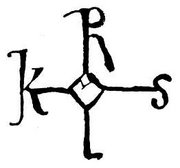 autograph of Charlemagne (King/Emperor of the Franks 768-814)
autograph of Charlemagne (King/Emperor of the Franks 768-814)
His grandson, Charles the Bald, was known to have had a personalised symbol on his war shield:
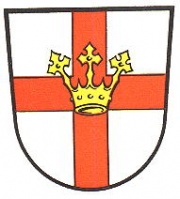 shield of Charles the Bald (King/Emperor of Neustria 843-877)
shield of Charles the Bald (King/Emperor of Neustria 843-877)
It was the Normans (1066-1154) who formalised heraldry and by the twelfth century many Norman lords had a "recognized" coat of arms. The first recorded heraldic debate broke out in 1385 when Sir Richard Le Scrope and Sir Robert Grosvenor, fought over the right to bear "Azure a bend Or". Le Scrope won, by the way.
In class-conscious societies, the use of heraldic devices became linked with systems of nobility, to the point that what you could display on your arms depended on your rank within the noble pecking order.
source: http://www.heraldry.ws/
From this we can learn that the Barlow family, as already established in the Domesday record, would have been among the first to be granted a heraldic crest of arms.
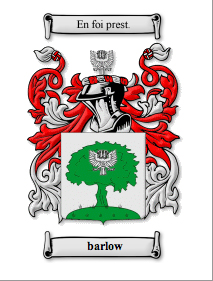
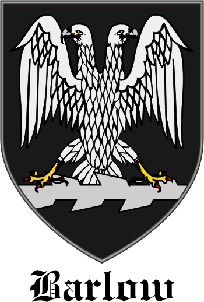
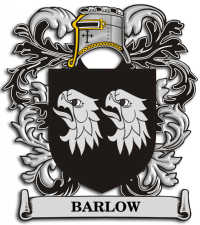
So, we can see here three different trends along the lines of the establishment of the indicative motif, the double-headed bird, being the Eagle, the Hawk, or possibly the Phoenix. It should be noted that the key feature in distinguishing the Barlow usage of this motif is its placement in a tree, although this does not appear to be a requisite of the motif itself.
The name barlow belongs to the early history of Britain since it was first used by the Anglo-Saxons. It is a product of their having lived in either Lancashire, Derbyshire, or Yorkshire, where there were places named Barlow. In Lancashire, the county from which most members of the family originally came, the places were Barlow Hale and Barlow Moor, near Manchester. In Derbyshire, Barlow is a parish near Chesterfield. In Yorkshire, Barlow is an area in the parish of Brayton in the West Riding.
Spelling variations include: Barlow, Barlowe, Barlo, Barloe and others.
First found in Cheshire, where they held a family seat from ancient times.
Some of the first settlers of this name or some of its variants were: Elizabeth Barlow who settled in Virginia in 1698; and Henry Barlow settled in Virginia in 1623; Abraham, Alfred, Ashton, Benjamin, Charles, Edward, George, Henry, James, John, Noah, Robert and Thomas Barlow, all landed in Philadelphia Pa. between 1771 and 1863.
Motto Translated: Ready in faith.
alchemy
The first true alchemist in Medieval Europe was Roger Bacon. Roger Bacon has also been attributed with originating the search for the philosopher's stone and the elixir of life: "That medicine which will remove all impurities and corruptibilities from the lesser metals will also, in the opinion of the wise, take off so much of the corruptibility of the body that human life may be prolonged for many centuries."
source: http://en.wikipedia.org/wiki/Alchemy
I'd like to make more extensive reference to the history of Roger Bacon in particular, not only as his life is, as it is, so exemplary of the life of the typical alchemist, seeking for acceptance that could never occur, often suffering instead, and usually ending in poverty and contempt. I'd like to mention it also as it is contemporary to the beginning of Hapsburg lineage, which will be delved into momentarily.
Roger Bacon (c. 1214 - 1294), also known as Doctor Mirabilis (Latin: "astounding teacher"), was one of the most famous Franciscan friars of his time. He was an English philosopher who placed considerable emphasis on empiricism, and has been presented as one of the earliest advocates of the modern scientific method; though later studies have emphasized his reliance on occult and alchemical traditions. He was intimately acquainted with the philosophical and scientific insights of the Arab world, one of the most advanced civilizations at the time.
Bacon was born near Ilchester in Somerset. His family appears to have been well-off, but, during the stormy reign of Henry III of England, their property was despoiled and several members of the family were driven into exile.
He later became a Franciscan friar. He probably took orders in 1253, after 10 years of study which had left him physically and mentally exhausted.
The two great orders, Franciscans and Dominicans, were not long-established, and had begun to take the lead in theological discussion. Alexander of Hales led the Franciscans, while the rival order rejoiced in Albertus Magnus and Thomas Aquinas. Bacon's abilities were soon recognised, and he enjoyed the friendship of such eminent men as Adam de Marisco and Robert Grosseteste *, bishop of Lincoln. In the course of his teaching and research, he performed and described various experiments.
Bacon wrote to the Cardinal Guy le Gros de Foulques, who became interested in his ideas and asked him to produce a comprehensive treatise. Bacon, being constrained by a rule of the Franciscan order against publishing works out of the order without special permission, initially hesitated. The cardinal became Pope Clement IV and urged Bacon to ignore the prohibition and write the book in secret. Bacon complied and sent his work, the Opus Majus, a treatise on the sciences (grammar, logic, mathematics, physics, and philosophy), to the pope in 1267. It was followed in the same year by the Opus Minus, a summary of the main thoughts from the first work. In 1268, he sent a third work, the Opus Tertium to the pope, who died the same year, apparently before even seeing the Opus Maius although it is known that the work reached Rome. Bacon fell out of favor, and was in fact later imprisoned by the Franciscan order for the second time in 1278 in Ancona as his dissemination of arab alchemy, and doubtless also his protests against the ignorance and immorality of the clergy, roused accusations of witchcraft. He stayed imprisoned for over ten years, until intercession of English noblemen secured his release. He died without important epigones or pupils and was quickly forgotten for a long time.
His "Opus Majus" contains treatments of mathematics and optics, alchemy and the manufacture of gunpowder, the positions and sizes of the celestial bodies, and anticipates later inventions such as microscopes, telescopes, spectacles, flying machines and steam ships. Bacon studied astrology and believed that the celestial bodies had an influence on the fate and mind of humans. He also wrote a criticism of the Julian calendar which was then still in use. He first recognized the visible spectrum in a glass of water, centuries before Sir Isaac Newton discovered that lenses could disassemble and reassemble white light.
Roger Bacon is widely considered to be one of the most likely authors of the Voynich Manuscript, given his studies in the fields of Alchemy, Astrology, and languages. Because the manuscript has eluded all attempts at translating, this is unconfirmed, however there is overwhelming evidence to support Bacon's authorship.
source: http://en.wikipedia.org/wiki/Roger_Bacon
* (Robert Grosseteste (1170 - 1253) was a pioneer of the scientific theory that would later be used and refined by the alchemists. He took Abelard's methods of analysis and added the use of observations, experimentation, and conclusions in making scientific evaluations. Grosseteste also did much work to bridge Platonic and Aristotelian thinking. (Hollister pp. 294-5))
source: http://en.wikipedia.org/wiki/Alchemy
As an aside, it has come to light in the past decade that the so-called "stone of the philosophers" was almost certainly a monoatomic form of gold, from the platinum group of metals, which could only be produced by prolonged exposure of base gold to near sun surface temperatures. I would further speculate this could have been accomplished through the application of Brown's Gas.
Brown's Gas, or Hydroxy gas as it is also known, is a stoichiometric mixture of monoatomic hydrogen and oxygen. Brown's gas is usually used for welding purposes because of its capability of welding metals at low temperatures. Its 'cold' flame is produced by an implosion, instead of an explosion, which means that a vacuum is created when the gas ignites.
source: http://en.wikipedia.org/wiki/Brown%27s_Gas
An eagle has two young. One is fledged, but the other, which is featherless, prevents it from flying. "Add the head of one to the other other, and you will have it," advises Maier (in Atalanta Fugiens, 1618).
source: The Hermetic Museum: Alchemy and Mysticism. Alexander Roob, Taschen publishing. p. 364
This is an example of the use of the eagle in symbolic Alchemy, as well as serves to be a shiningly fine example of the flowery style of Alchemical commentators. For Alchemists after the Renniassance, the illustrious fables using animal imagery were a necessary deception for steeping their manuscripts in mystery in order to protect the arcane science of their art.

For Hieronymous Reussner (Pandora, Basle, 1582), the dragon that grows from the "philosopher's tree" is "our Mercury" or "the water of life" from which God created all things. United in it, are the powers of the six planets and metals. The double-headed eagle of the Hapsburgs symbolises the fixed and volatile components of matter.
source: The Hermetic Museum: Alchemy and Mysticism. Alexander Roob, Taschen publishing. p. 416
A great deal more could and SHOULD be said than has been thus far recording the contemporary politics of the late Medieval, Rennaissance, and early Enlightenment as relative to the quasi-political mystic symbolism of the Alchemical manuscripts of the same eras. I will suffice it only to say for the purpose of this exposition here that, by the time the double-headed bird was depicted by Reussner, for example (1582), it had already been established as a symbol indicating the Hapsburg royal family, which had been seated as the hereditary Holy Roman Emperors from the 1270's.
hapsburg-romanov crests
From Counts of Habsburg to Holy Roman Emperors
The name is derived from the Swiss Habichtsburg (Hawk Castle), the family seat in the 11th, 12th and 13th centuries at Habsburg, Switzerland (Switzerland did not then exist in its present form, and the Swiss lands were part of the mainly Germanic Holy Roman Empire). From South-East-Germany the family extended its influence and holdings to the eastern reaches of the Holy Roman Empire, roughly today's Austria (1278 - 1382). Within only two or three generations, the Habsburgs had managed to secure an initially intermittent grasp on the imperial throne that would last for centuries (1273 - 1291, 1298 - 1308, 1438 - 1740, and 1745 - 1806).
After the marriage of Maximilian I with Mary, heiress of Burgundy (the Low Countries) and the marriage of his son Philipp the Handsome with Juana, heiress of Spain and its newly-founded empire, Charles V inherited an empire where "the sun does not set".
source: http://en.wikipedia.org/wiki/Hapsburg
So we see that the Hapsburg dynasty was only beginning to flourish at the same time as the birth and bourgeoining of the Alchemical movement, as well as the Norman rule of England, the Domesday manual and the proper formalisation of Heraldry, though all of these have been proven to be ex post facto the origins of the Barlow family in Derbyshire and Yorkshire.
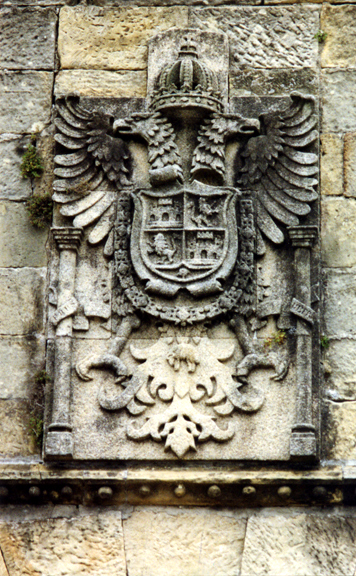
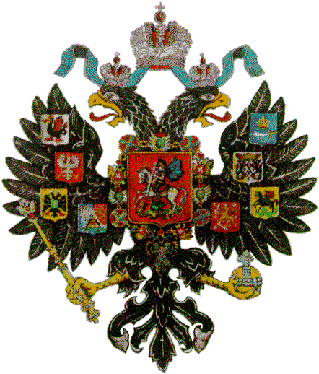
Here (above left) we see the primary significant difference between the use of the double-headed bird in the Hapsburg family crest, and that of the same, or rather, similar, symbol in the even earlier crest of the Barlow family. While in the Barlow crest the motif occured upon the SHIELD of the heraldry, in the Hapsburg use it appears as the SUPPORTER thereof.
Also depicted here (above right) is the Romanov family heraldry, the final family to hold the title of Tsar of Russia. By the time of the beginning of the Romanov reign (1645 under Alexis I), the double-headed bird motif was already well established by the Hapsburgs as a symbol associative of rule by Imperial right. Since the Romanovs operated under the auspices of the Orthodox Church (seated in Constantinople) in much the same capacity as the HRE did relative to the Papal Catholic Church, it should not be particularly of interest to see the motif repeated here. Again, the motif is used in place of the SUPPORTER of the crest, and thus should not be confused so as to have any reference soever to the Barlow SHIELD.
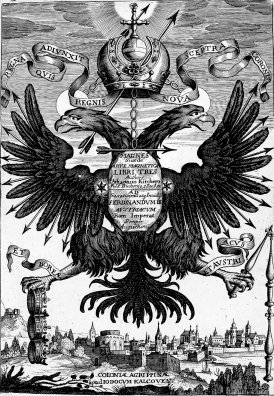
Here, again, is the Hapsburg eagle, presented for the purpose of a piece of political propaganda with text in place of the graphic elements on its shield. This should underscore the difference aforementioned. Also, it shows the standard variation between the motif with wings lowered and wings raised as evidence these two are essentially synonimous and interchangeable without commentary therewith on the inherent meaning of the motif.
33rd degree
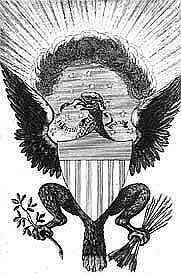 The Trenchard prototype for the obverse of the United States seal.
The Trenchard prototype for the obverse of the United States seal.
The origins of the 33rd degree symbol of Scottish Rite Freemasonry are more steeped in mystery than almost any other symbol of the moral craft. For example, the exact type of bird illustrated therein continues to be a debate even during these early years of the twenty-first century. Many modern Masons accept it as simply an eagle, however many anti-Masons continue their derisive charge that the bird is actually associated with the Alchemical phoenix, known as Azoth. As I say, there is as of yet no standard consensus, even between the practical historians and the speculative symbologists within the Lodge itself.

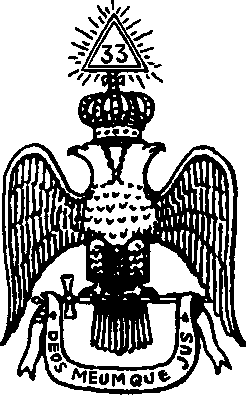
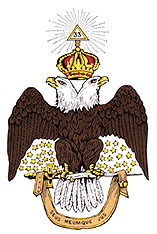
It should also be noted here that the symbol of the 33rd degree is NOT, in fact, the symbolic heraldry of the Craft. While the eagle, or phoenix, is familiar now from a cursory study of the crests of European noble families, the crest and arms of the Lodge are to be held devoutly distinct from it. The actual crest and arms of Masonry are depicted here (on the left) with the crest and arms of the Grand Lodge of England (on the right) for comparison. I feel the symbolism of these is, contrary to that of the double-headed bird motif, so blatantly obvious that it does not even deserve further commentary.
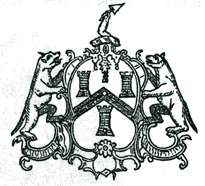
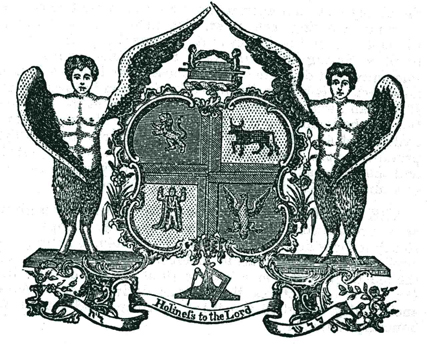
-------------------------------------------------------------------------------------------------------------------
this information is all public domain, or © the respective site authors where applicable
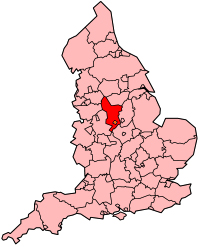
 autograph of Charlemagne (King/Emperor of the Franks 768-814)
autograph of Charlemagne (King/Emperor of the Franks 768-814) shield of Charles the Bald (King/Emperor of Neustria 843-877)
shield of Charles the Bald (King/Emperor of Neustria 843-877)






 The Trenchard prototype for the obverse of the United States seal.
The Trenchard prototype for the obverse of the United States seal.



